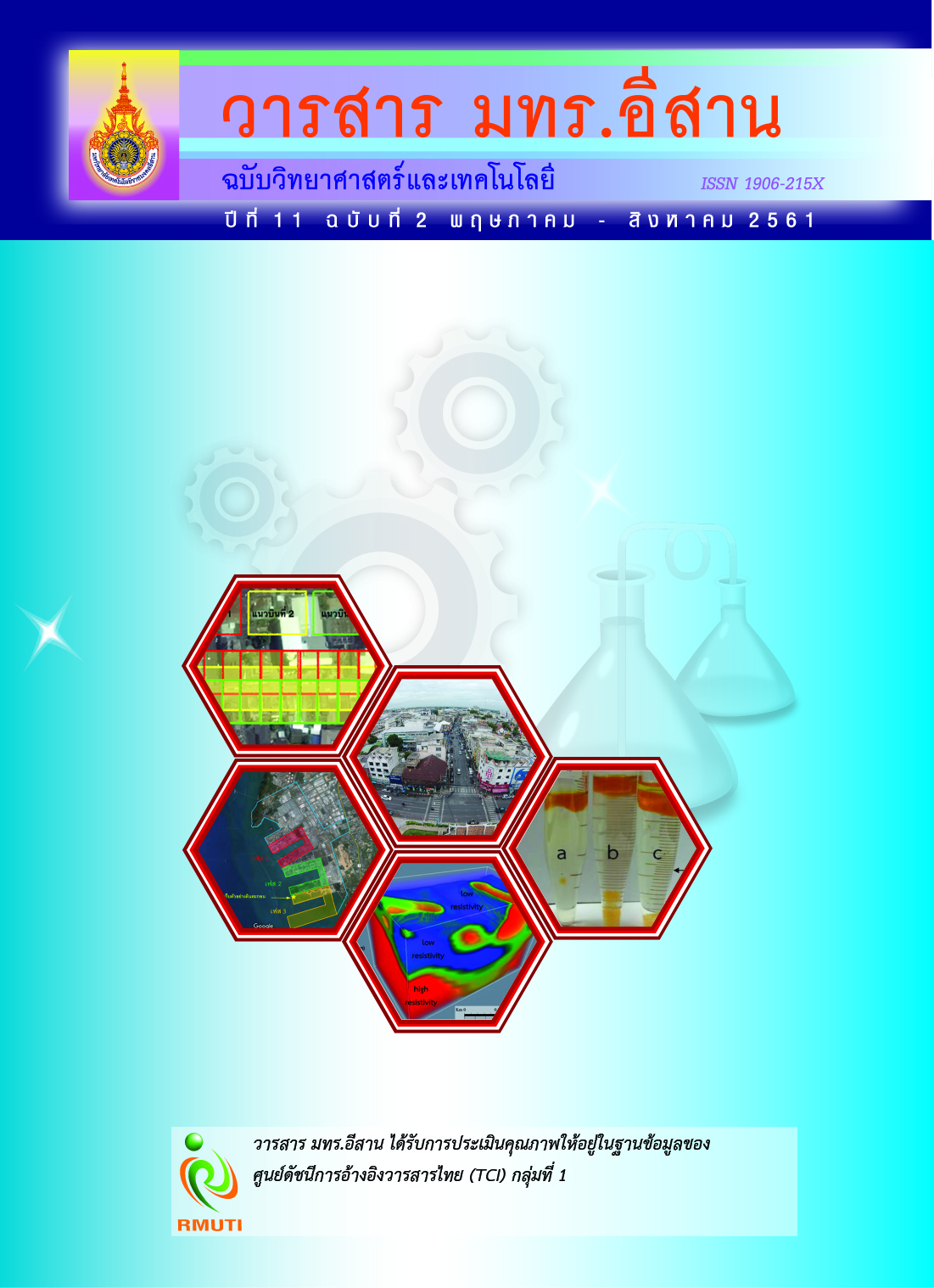คุณภาพนํ้าหลังการรื้อถอนร้านค้าที่รุกลํ้าคลองโอ่งอ่าง
Main Article Content
บทคัดย่อ
คลองโอ่งอ่างเป็นคลองประวัติศาสตร์ของกรุงเทพมหานครที่มีร้านค้ารุกลํ้าพื้นที่คลองมาเป็นเวลาเกือบ 30 ปี ซึ่งส่งผลกระทบต่อการระบายนํ้า ทำให้เกิดปัญหานํ้าเน่าเสีย ปี 2558 กรุงเทพมหานครจึงได้ใช้กฎหมายดำเนินการรื้อถอนร้านค้าที่รุกลํ้า ดังนั้น งานวิจัยจึงมีวัตถุประสงค์เพื่อศึกษาปัจจัยที่มีผลต่อคุณภาพน้ำในคลองโอ่งอ่าง ได้แก่ การรื้อถอนร้านค้าที่รุกล้ำพื้นที่คลอง เดือนที่เก็บตัวอย่าง และการปิดเปิดประตูระบายนํ้า และระบุประเภทของแหล่งนํ้าผิวดิน คุณภาพนํ้าที่ศึกษาประกอบด้วย สี กลิ่น ความขุ่น การละลายน้ำของออกซิเจน (DO) ความสกปรกของน้ำในรูปสารอินทรีย์ (BOD) แบคทีเรียกลุ่มโคลิฟอร์ม (TCB) และแบคทีเรียฟีคัลโคลิฟอร์ม (FCB) โดยสุ่มเก็บตัวอย่างน้ำ 3 ครั้ง ในเวลา 6 เดือน และเก็บตัวอย่าง 2 เวลา ได้แก่ ก่อนเปิดและหลังปิดประตูระบายนํ้า ผลการวิจัยพบว่า นํ้าคลองมีสีเขียว ขุ่น และไม่มีกลิ่น ในเดือนที่ 1 และ 3 แต่ใส ไม่มีสี และไม่มีกลิ่นในเดือนที่ 6 ส่วนค่า DO อยู่ในช่วง 3.12 - 5.49 มก./ล.
ค่า BOD อยู่ในช่วง 4.39 - 14.03 มก./ล. ค่า TCB อยู่ในช่วง 1.95 x 105 - 1.95 x 106 MPN/100 มล. และค่า FCB อยู่ในช่วง 6.65 x 104 - 6.37 x 105 MPN/100 มล. ขณะที่ DO และ FCB มีค่าสูงกว่า ข้อมูลก่อนการรื้อถอนในปี พ.ศ. 2526 2541 และ 2555 ที่ระดับนัยสำคัญ 0.05 DO ยังมีค่าอยู่ในเกณฑ์มาตรฐาน ในขณะที่ FCB มีค่าเกินเกณฑ์มาตรฐาน ส่วน WQI (Water Quality Index) มีค่าเป็น24.01 จึงจัดว่าคลองโอ่งอ่างเป็นแหล่งน้ำผิวดินประเภทที่ 5 ที่สามารถใช้ประโยชน์ได้ในการคมนาคมเท่านั้น
Article Details
เอกสารอ้างอิง
[2] Dailynews team. (2015). Announcement of Water and Electricity Cut off to Seller at Saphan Lhek by using law of Revolutionary. Access (18 February 2016). Available (https://www.dailynews.co.th/bangkok/350205) (in Thai)
[3] Kent, M. (2014). How to Identify Pollution. Access (4 February 2016). Available (https://classroom.synonym.com/identify-pollution-22930.html)
[4] Rojjanaburanont, T. (1983). Study of Water Environment of main canal in Bangkok. Research Report. Bangkok, Chulabhorn Research Institute. (in Thai)
[5] Uawongsajja, W. (1998). Investigation of Water Environment in Banglumpoo-Ong Ang Canal. Senior Project, General Science Department, Faculty of Science, Chulalongkorn University, Thailand. (in Thai)
[6] National Statistical Office. (2002). Environment of Thailand in 2002 about Water Quality of Canals in Bangkok. Research report. Bangkok. (in Thai)
[7] Department of Drainage and Sewerage, Bangkok. (2013). Water Quality of Canels in Bangkok in 2012. Access (30 December 2016). Available (https://service.nso.go.th/nso/nso_center/project/table/files/1500901/2555/000/10_1500901_2555_000_000000_00100.xls) (in Thai)
[8] APHA - AWWA - WEF (American Public Health Association - American Water Works association - Water Environment Federation). (2005). Standard Methods for the Examination of Water and Wastewater. Access (10 March 2016). Available (https://www.standardmethods.org)
[9] Pollution Control Department. (2016). Calculation of General Water Quality Index: WQI. Access (21 December 2016). Available (https://iwis.pcd.go.th/index.php?method=calculate&etc=1533878670804) (in Thai)
[10] Hanmongkolpipat, P. (2004). Statistics and Experimental Design. 2nd edition. Kasetsart University Publisher, Bangkok. (in Thai)
[11] Royal Irrigation Department, Ministry of Agriculture and Cooperative. (2011). Study of Water Quality of Chaophraya River following Command of Queen Sirikit. Access (18 February 2016). Available (https://kmcenter.rid.go.th/kchydhome/documents/2554/article/sed012.pdf) (in Thai)
[12] Choo-in, S. (2012). Water Quality Management Klong Wat Rajathiwas, Dusit, Bangkok By Water Replacement. Research Report. Suan Sunandha Rajabhat University Bangkok. (in Thai)
[13] Onnom, R. (1997). Study of Water Quality and Effect of Dam Use in Bangprakong River. M.S. Thesis, Environmental Engineering, Faculty of Engineering, Kasetsart University, Thailand. (in Thai)
[14] System of Law Data of Water Management. (2016). Announcement of National Environmental Council. Access (10 July 2016). Available (https://hydrolaw.thaiwater.net/web/) (in Thai)
[15] Riyakan, I. (2013). Wastewater Treatment by Effective Microorganism Ball: A Case of Study of Wastewater Sample from Sansab Canal. SDU Research Journal. Vol. 6, No. 2, pp. 153-168. (in Thai)
[16] Salab, K. (2017). Chiang Mai Water Disaster The Director General of the Pollution Control Department Has to Manage the Water System, Resolving Problems of Mae Kha Canal and Moat. Access (21 June 2017). Available (https://www.tnews.co.th/contents/318342) (in Thai)
[17] Chiratthiti, C., Sakulkaew, K., Pinijwejchakarn, S., Yookongkarm, S., Langla, D., and Kaewkiaw, A. (2016). The Study of Health Affected by Bacterial Water Quality of Chao Phraya River. Access (30 December 2016). Available (https://bkkthon.ac.th/home/user_files/department/department-24/files/8-57.pdf) (in Thai)


